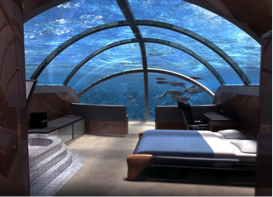Sea level rise as a consequence of climate change is expected to cause destruction to many coasts at best and topple entire island nations at worse. But what if part of our adaptation strategy was to embrace the abundant salty water that makes up over 70% of Earth? From desalination plants that manufacture potable water to new maritime and trade routes in the Arctic, our connection to the sea is becoming strengthened because of climate change. Human beings are land creatures, but we have managed to fly in the air and float on water. Now deep ocean technology and advanced construction methods are ushering in a new era of where we sleep. Welcome to the underwater hotel.

The first underwater hotel was built in the Bora Bora Lagoon in the Florida Keys, USA. Jules’ Undersea Lodge sits at a depth of about 9 meters below the surface, made of mostly steel and acrylic. Open to the general public since 1986, this lodge requires people to dive below the surface before accessing the structure.
The Water Discus Underwater Hotel is located at a coral reef site in Dubai, United Arab Emirates. The concept is a disk-shaped oversea and undersea structure. The undersea disk is located at 10 meters below sea level. A second large disk structure, together with a series of smaller satellite disks, are elevated 5 to7 m above the water; five support legs anchor the hotel complex to the seabed.
The Utter Inn in Sweden and Manta Resort in Tanzania were designed by Mikael Genberg to resemble local homes. In Västerås, Sweden, the Utter Inn provides a one-room hotel for guests to sleep 3 meters below Lake Mälaren. Guests enter the hotel through what looks like a Swedish house located above the surface of the water. The Manta Resort in Tanzania allows guests to sleep 4 meters below the Indian Ocean’s surface. The room is a floating structure (though anchored on four sides) that is located 250 meters from the shore. Visitors can climb a ladder to a rooftop area above the surface.
At about 5 meters below the surface, The Ithaa Underwater Restaurant in the Maldives provides a space for gathering and eating (but no sleeping). Visitors enter using a staircase at the end of a jetty. The mostly acrylic tunnel-like structure was constructed in Singapore and then brought to the Maldives by boat. The structure was then driven under water by piling on 85 tons of sand, moving the object onto four steel piles, and securing the structure with concrete.
A myriad of improvements and new technologies in materials, ocean engineering, and submarine and ship building have permitted the feasibility of underwater hotels. These advances include modular construction techniques, Underwater concreting has improved (techniques that minimize rapid interface flow when cement comes into contact with water), and alloys more resistant to corrosion (notably cathodic protection and epoxy coating systems). However, when it comes to undersea construction, highly skilled divers that are able to build, weld, and piece together parts underwater are often indispensible.
Other planned underwater hotels include the Hydropolis in Dubai and Fiji’s Poseidon Undersea Resort.
While an ocean littered with hotels may cause more disruption than good, a few well-planned and sustainability-focused locations can increase awareness about ocean health and the environment in general. And it may just be a feasible alternative to coastal land-based accommodation in light of climate change. Sustainable building certification bodies may want to add underwater building sustainability codes to their “to-do” lists. The thought of sleeping surrounded by corals, star fish and sea horses is a new reality.






